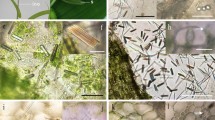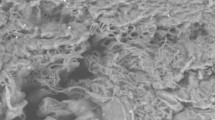Abstract
Radicle of matureEchinocactus platyacanthus embryo is approximately 320 μm long and represents less then 1/7 of the embryonal axis length. The radicle-hypocotyl boundary can be distinguished according to the striking difference in the size and shape of cells in protoderm and procambium, as well as discontinuity and different number of the cell files in the ground meristem. The root cap is small, consists of 4 layers of cells covering the apex of the radicle. The upper limit of the root cap is approximately 100 μm closer towards the radicle tip than the radicle-hypocotyl boundary. Ultrastructure of radicle cells showed numerous lipid bodies as is typical for other oily seeds. Protein bodies of variable structure were also present together with other cell structures. Striking differences in protein body structure were found when protoderm and ground meristem were compared. Several small globoid crystals were present in each protein body of the protoderm, while protein bodies in the radicle ground meristem mostly contained one large globoid crystal. X-ray microanalysis revealed presence of P, K and Mg in all analyzed globoid crystals. Fe, Ca and Zn were detected in some of them.
Similar content being viewed by others
Abbreviations
- EDX microanalysis:
-
energy-dispersive X-ray microanalysis
- GC(s):
-
globoid crystals
- ICP spectroscopy:
-
ion-coupled plasma spectroscopy
- LM:
-
light microscopy
- PB(s):
-
protein bodies
- SEM:
-
scanning electron microscopy
- TEM:
-
transmission electron microscopy
References
BuxbaumF 1955 Morphology of Cacti. Section III. Fruits and Seeds. pp 174–223. Abbey Garden Press, Pasadena.
ChenP and LottJ N A 1992 Studies ofCapsicum annuum seeds: structure, storage reserves and mineral nutrients. Can. J. Bot. 70, 518–529.
Dierks-VentlingC and VentlingD 1982 Tissue-specific immunoflu-orescent localization of zein and globulin inZea mays L. seeds. FEBS Lett. 144, 167–172.
KurasM 1978 Activation of embryo during rape (Brassica napus L.) seed germination. I. Structure of embryo and organization of root apical meristem. Acta Soc. Bot. Pol. 47, 65–82.
LottJ N A 1980 Protein bodies.In The Biochemistry of Plants, Vol 1. Eds. P KStumpf and E EConn. pp 589–625. Academic Press, Inc, New York, London, Toronto, Sydney, San Francisco.
LottN A and ButtroseM S 1978 Thin sectioning, freeze fracturing, energy dispersive X-ray analysis, and chemical analysis in the study of inclusions in seed protein bodies: almond, Brazil nut, and quandong. Can. J. Bot. 56, 2050–2061.
LottJ N A, GoodchildD J and CraigS 1984 Studies of mineral reserves in pea (Pisum sativum) cotyledons using low-water-content procedures. Can. J. Bot. 62, 459–469.
LuxA 1981 A rapid method for staining semi-thin sections of plant material. Biológia (Bratislava) 36, 753–757 (In Slovak)
LuxA 1990 Ultrastructure of seeds in the familyCactaceae. Mature embryo ofAstrophytum asterias (Zucc.) Lem. Acta F.R.N. Univ. Comen-Physiol. Plant. 26, 59–64.
LuxA, BobákM and MikusM 1992 Protein bodies from radicle of maize and barley: their structure and elemental composition of globoid crystals.In Root Ecology and its Practical Application, 3.ISRR Symp. Wien, Univ. Bodenkultur, 1991. Eds. LKutschera, EHübl, ELichtenegger, HPersson and MSobotik. pp 9–12. Verein für Wurzelforschung, Klagenfurt.
MaldonadoS and LottJ N A 1991 Protein bodies inDatura stramonium seeds: Structure and mineral nutrient composition. Can. J. Bot. 69, 2545–2554.
Mikuš M, Lux A, Crans D C, Shin P K and Krištín J 1994 Comparison of phytate in radicle, plumula, scutellum and endosperm ofZea mays andZea diploperennis seeds. Plant and Soil (In press).
MikušM, BobákM and LuxA 1992 Structure of protein bodies and elemental composition of phytin from dry germ of maize (Zea mays L.). Bot. Acta 105, 26–33.
MikušM and LuxA 1990 Heterogeneity of protein bodies in dry and germinating seeds of barley (Hordeum distichum L.). Acta F.R.N. Univ. Comen.-Physiol. Plant. 25, 51–60.
SkilnykH R and LottJ N A 1992 Mineral analysis of storage reserves ofCucurbita maxima andCucurbita andreana pollen. Can. J. Bot. 70, 491–495.
SpitzerE and LottJ N A 1980 Thin-sectioning, freeze-fracture, and energy dispersive X-ray analysis studies of the protein bodies of tomato seeds. Can. J. Bot. 58, 699–711.
TrujilloS 1984 Distribución geográfica y ecológica deEchinocactus platyacanthus. Un ejemplo de distribución disyunta. Cact. Suc. Mex. 29, 75–80.
TykarskaT 1979 Rape embryogenesis. II. Development of embryo proper. Acta Soc. Bot. Pol. 48, 391–421.
TykarskaT 1987 Rape embryogenesis. VI. Formation of protein bodies. Acta Soc. Bot. Pol. 56, 585–597.
TykarskaT and KurasM 1994 The origin of the basal part of the embryo root inBrassica napus L. and its role in growth of early seedlings. Structure and Function of Roots. Eds. FBaluška, OGašparíková and MČiamporavá. Kluwer Academic Publishers, Dordrecht.




